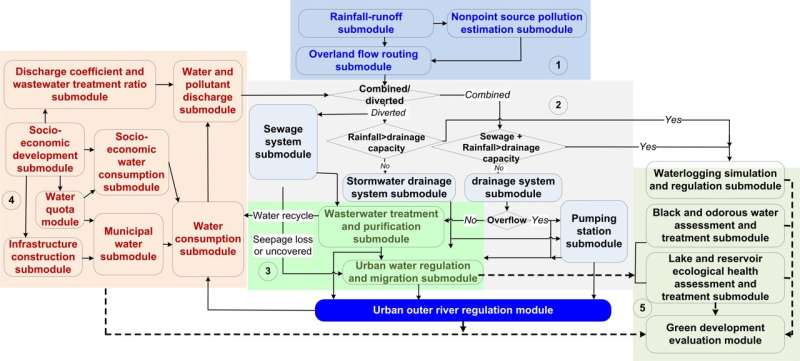This article has been reviewed according to Science X's editorial process and policies. Editors have highlighted the following attributes while ensuring the content's credibility:
fact-checked
peer-reviewed publication
trusted source
proofread
Urban water system theory 5.0 offers a systematic solution to complex urban water issues in China

The urban water system theory is the application and extension of watershed hydrological science to an urban scale. In a paper published in Science China Earth Sciences, a research group led by Chinese academician Xia Jun introduced the urban water system 5.0 theory and associated model. This study aims to advance interdisciplinary study in urban water sciences and offer a systematic solution to complex urban water issues.
Previous research on urban water systems primarily focused on individual processes within the water cycle, such as those related to water supply and sewage treatment plants, which has significantly advanced our understanding of urban water system theory.
With the advent of sponge city construction in China, however, the focus of the urban water system studies has shifted from traditional considerations of rainfall-runoff yield, water supply, and drainage processes to a more comprehensive examination of multiple water system processes. Nevertheless, further exploration is needed to understand the interplay between the water cycle, material transport, water ecology, and human activities.
Professor Xia extended the concept of the urban water systems by transitioning from the natural water cycle to an urban scale, and thus established the urban water system 5.0 theory. This theory emphasizes mechanisms, system theories, and technological integrations of urban water cycles tailored to different climatic zones and geographical subdivisions in China.
The primary focus of research is using the hydrological cycle as a link to comprehensively explore the built-up areas and its associated rivers and lakes with multiple processes. These processes encompass the natural water cycle of rainfall, evapotranspiration, storage, and runoff, the artificial water cycle of supply, use, consumption, and discharge, the interaction between rivers and cities, the biogeochemical cycle, the pollutant migration and transformation, and socioeconomic development.
The urban water system 5.0 model integrates a Time-Variant Gain Rainfall-Runoff Model with urban water systems tailored to various underlying surface conditions. The Time-Variant Gain Rainfall-Runoff Model serves as the core, and extends its simulation capabilities to nonpoint source pollution, water and pollutant transport within drainage networks, waterlogging, socioeconomic water cycles, wastewater treatment, and water regulation and purification.
This integration facilitates the seamless interaction between natural and social water cycles, incorporating multi-scale sponge measures, and addressing water quantity, quality and ecological processes. The model comprises five primary simulation functions: rainfall-runoff and nonpoint source pollutant load, water and pollutant transportations of the drainage networks, terminal regulation and purification, socioeconomic water cycles, and water system assessment and regulation.
The successful application of the urban water system 5.0 model in Wuhan, a core city in the urban agglomeration of the middle reaches of the Yangtze River, demonstrates the feasibility of the model in simulating key processes of the urban water cycle. The model performed well for the simulation of urban rainfall-runoff processes, total nitrogen (TN) and total phosphorus (TP) concentrations in water bodies, and the critical socioeconomic development indicators.
Some control measures were proposed for waterlogging points, the black and odorous level of water bodies, lake eutrophication levels, and green development, respectively. These measures reduced the maximum inundated area in a once-in-a-decade rainfall by 32.6%, black and odorous water bodies by 65%, comprehensive trophic state index of the water bodies by 37%. They also contributed to an increase of 21% in the green development.
The theory of urban water system 5.0 and its associated model represents a significant advancement in modeling the water systems of contemporary cities. This approach facilitates the integration of diverse disciplines pertaining to urban environments and water management.
Moving forward, it is imperative to enhance the conceptual and theoretical-technical system of urban water systems. This involves refining the model structure, expanding its functionalities, and bolstering the observation and data collection related to water system processes. These efforts are essential for validating the performance of model simulations and ensuring their accuracy.
More information: Jun Xia et al, Urban water system theory and its model development and application, Science China Earth Sciences (2024). DOI: 10.1007/s11430-023-1226-9
Journal information: Science China Earth Sciences
Provided by Science China Press




















